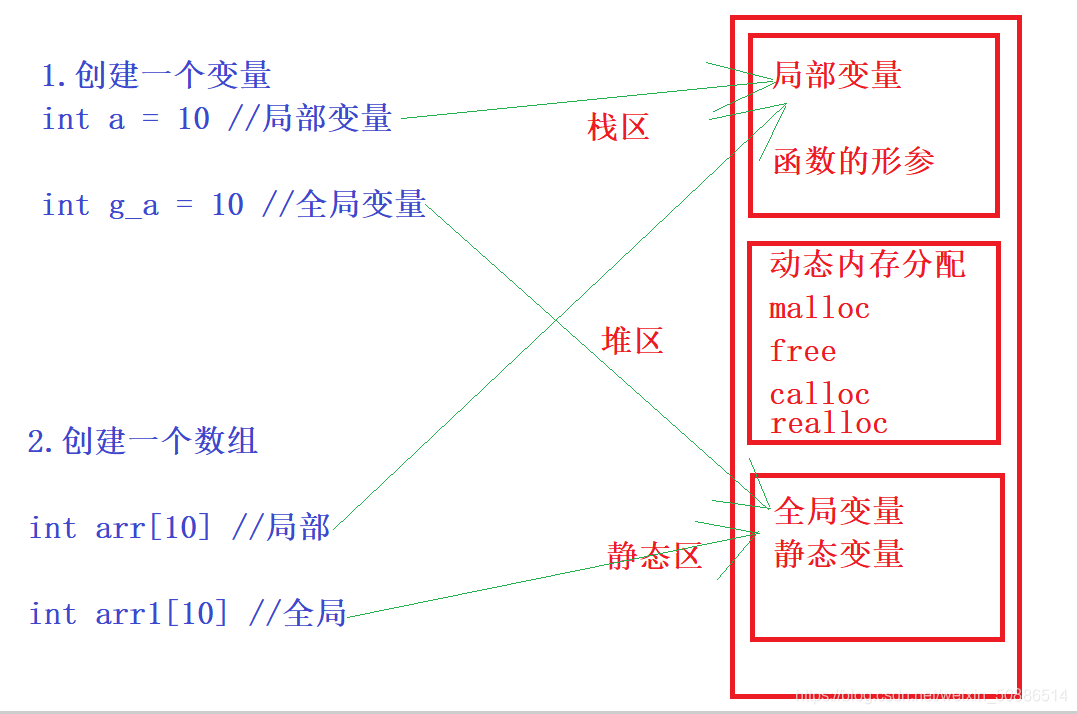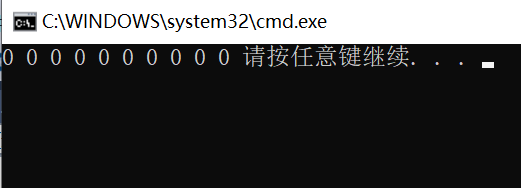为什么存在动态内存分配,动态内存函数(malloc函数,free函数,calloc函数,realloc函数)
本文共 3209 字,大约阅读时间需要 10 分钟。
目录:
1.当前我们知道的内存的使用方法

2.为什么存在动态内存分配
如上我们已学的开辟空间的方式有两个特点:
(1) 空间开辟的大小是固定的 (2) 必须指定数组的长度 所以就产生了空间开大了浪费开小了不够用的问题,所以使用动态内存分配3.动态内存函数
3.1 malloc 和 free
(1) malloc函数

(2) free函数

(3) 举例说明malloc函数和free函数如何使用
a. 开辟10个整形大小的空间,并将0-9放入
#define _CRT_SECURE_NO_WARNINGS#include#include #include int main(){ //向内存申请10个整形的空间 int* p = (int*)malloc(10 * sizeof(int)); //开辟空间失败,打印失败原因 if (p == NULL) { //errno:Last error number printf("%s\n", strerror(errno)); } //开辟空间成功,将0-9放入 else { for (int i = 0; i < 10; i++) { *(p + i) = i; } for (int i = 0; i < 10; i++) { printf("%d ", *(p + i)); } } //释放掉p指向的这段空间,但是指针p还是指向这段空间 free(p); //防止野指针,需要将指针制空 p = NULL; return 0;}

b. 开辟空间失败,并打印开辟失败原因
• INT_MAX 整形最大–>可右键转到定义查看

#define _CRT_SECURE_NO_WARNINGS#include#include #include int main(){ //向内存申请10个整形的空间 int* p = (int*)malloc(INT_MAX); //开辟空间失败,打印失败原因 if (p == NULL) { //errno:Last error number printf("%s\n", strerror(errno)); } //开辟空间成功,将0-9放入 else { for (int i = 0; i < 10; i++) { *(p + i) = i; } for (int i = 0; i < 10; i++) { printf("%d ", *(p + i)); } } //释放掉p指向的这段空间,但是指针p还是指向这段空间 free(p); //防止野指针,需要将指针制空 p = NULL; return 0;}

3.2 calloc
(1) calloc函数

(3) 举例说明calloc函数如何使用
a.开辟10个整形大小的空间并初始化为0
#include#include #include int main(){ int* p = (int*)calloc(10, sizeof(int)); if (p == NULL) { printf("%s\n", strerror(errno)); } else { for (int i = 0; i < 10; i++) { printf("%d ", *(p + i)); } } free(p); p = NULL; return 0;}


3.3 realloc
(1) realloc函数

(2)realloc在调整内存空间存在的两种情况:
• 情况1:原有空间之后有足够大的空间
如果p指向的空间之后有足够的内存空间可以追加,则直接追加,然后返回p

#include#include #include int main(){ int* p = (int*)malloc(20); if (p == NULL) { printf("%s\n", strerror(errno)); } else { for (int i = 0; i < 5; i++) { *(p + i) = i; } } //得用一个新的变量来接受realloc函数的返回值 //防止开辟失败返回NULL给p找不到之前的空间 int*ptr = (int*)realloc(p,40); if (ptr != NULL) { p = ptr; for (int i = 5; i < 10; i++) { *(p + i) = i; } for (int i = 0; i < 10; i++) { printf("%d ", *(p + i)); } } free(p); p = NULL; return 0;}


• 情况2:原有空间之后没有足够大的空间
如果p指向的空间之后没有足够大的内存空间可以追加,则realloc函数会重新找一块新的内存区域,开辟一块满足需求的空间,并把原来内存中的数据拷贝到新的空间,释放旧的内存空间,最后返回新开辟的内存空间地址

#include#include #include int main(){ int* p = (int*)malloc(20); if (p == NULL) { printf("%s\n", strerror(errno)); } else { for (int i = 0; i < 5; i++) { *(p + i) = i; } } //得用一个新的变量来接受realloc函数的返回值 //防止开辟失败返回NULL给p找不到之前的空间 int*ptr = (int*)realloc(p,4000); if (ptr != NULL) { p = ptr; for (int i = 5; i < 10; i++) { *(p + i) = i; } for (int i = 0; i < 10; i++) { printf("%d ", *(p + i)); } } free(p); p = NULL; return 0;}


注意:得用一个新的变量来接受realloc函数的返回值,防止开辟失败返回NULL给p找不到之前的空间
转载地址:http://kpdz.baihongyu.com/
你可能感兴趣的文章
Mysql-丢失更新
查看>>
Mysql-事务阻塞
查看>>
Mysql-存储引擎
查看>>
mysql-开启慢查询&所有操作记录日志
查看>>
MySQL-数据目录
查看>>
MySQL-数据页的结构
查看>>
MySQL-架构篇
查看>>
MySQL-索引的分类(聚簇索引、二级索引、联合索引)
查看>>
Mysql-触发器及创建触发器失败原因
查看>>
MySQL-连接
查看>>
mysql-递归查询(二)
查看>>
MySQL5.1安装
查看>>
mysql5.5和5.6版本间的坑
查看>>
mysql5.5最简安装教程
查看>>
mysql5.6 TIME,DATETIME,TIMESTAMP
查看>>
mysql5.6.21重置数据库的root密码
查看>>
Mysql5.6主从复制-基于binlog
查看>>
MySQL5.6忘记root密码(win平台)
查看>>
MySQL5.6的Linux安装shell脚本之二进制安装(一)
查看>>
MySQL5.6的zip包安装教程
查看>>